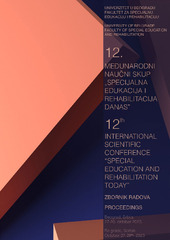Kvalitet glasa kod dece sa specifičnim jezičkim poremećajem
Voice quality in children with specific language Impairment
| dc.creator | Mirjana, Petrović Lazić | |
| dc.creator | Ilić Savić, Ivana | |
| dc.date.accessioned | 2024-01-09T10:52:09Z | |
| dc.date.available | 2024-01-09T10:52:09Z | |
| dc.date.issued | 2023 | |
| dc.identifier.isbn | 978-86-6203-174-7 | |
| dc.identifier.uri | http://rfasper.fasper.bg.ac.rs/handle/123456789/5335 | |
| dc.description.abstract | Uvod: Specifični jezički poremećaj (SJP) karakteriše kašnjenje ili atipičan obrazac u razvoju ekspresivnih i/ili receptivnih jezičkih sposobnosti uz odsustvo opšteg kognitivnog deficita, autizma, slušnih oštećenja, socijalnih i emocionalnih poremećaja i teške sredinske deprivacije. Cilj: Cilj ovog istraživanja je utvrđivanje karakteristika kvaliteta glasa i analiza učestalosti nepravilnosti u perceptivnim karakteristikama glasa kod dece sa specifičnim jezičkim poremećajem. Dodatni cilj podrazumevao je utvrđivanje polnih razlika u kvalitetu glasa kod ove dece. Metode: Uzorkom je obuhvaćeno 30 dece sa specifičnim jezičkim poremećajem, uzrasta od tri do devet godina (AS=6,40; SD=1,714), od kojih je 20 dečaka i 10 devojčica. Za procenu kvaliteta glasa korišćena je GRBAS skala. Rezultati: Dobijeni rezultati pokazuju da 36,7% ispitanika ima promuklost i šumnost u glasu, dok je napetost u glasu registrovana kod 46,7% ispitanika. Hrapavost glasa je najmanje zastupljena kod dece sa specifičnim jezičkim poremećajem (30%), dok je najčešća karakteristika kvaliteta glasa bila slabost u glasu (53,3%). Perceptivne promene glasa najčešće su okarakterisane kao promene blagog stepena, potom slede umerene, a najmanje su zastupljene izražene promene glasa. Postoje značajne razlike u stepenu promuklosti i hrapavosti glasa u odnosu na pol u korist dečaka. Zaključak: Iako su kod malog broja dece registrovane teškoće, one imaju značajne naučne i praktične implikacije. Njihova važnost ogleda se u značaju perceptivne procene glasa na ranom uzrastu od strane logopeda, koji poseduje stručne kompetencije za prepoznavanje mogućih smetnji u glasu. Na taj način ostvareni su svi uslovi za zdrav i kvalitetan glas kod dece. | sr |
| dc.description.abstract | Introduction: Specific language impairment (SLI) is characterized by a delay or abnormality in the development of expressive and/or receptive language skills in the absence of general cognitive deficits, autism, hearing impairments, social and emotional disturbances, and severe environmental deprivation. Aim: The aim of this research was to determine the quality of voice and analysis of the frequency of irregularities in the perceptual characteristics of voice in children with specific language impairment. Also, the goal was to determine possible gender differences in the voice quality of these children. Methods: The sample included 30 children with specific language disorders, 3-9 years of age (M=6.40; SD=1.714), of which 20 were boys and 10 were girls. The GRBAS scale was used to assess voice quality. Results: The results showed that 36.7% of respondents had hoarseness in their voice, while tension in the voice was registered in 46.7% of respondents. Voice hoarseness was the least represented in children with specific language disorders (30%), while the most common voice pathology was voice weakness (53.3%). The most common perceptual voice changes were mild, followed by moderate, and the least pronounced voice changes. There were significant differences in the degree of hoarseness and roughness of voice in relation to gender, more pronounced in boys. Conclusion: Although difficulties were registered in a small number of children, they have significant scientific and practical implications. Their importance is reflected in the importance of perceptual assessment of voice in the early period by a vocal pathologist, who has a trained sensibility for expert recognition of possible voice disturbances. In this way, all possible conditions are met to preserve healthy and high-quality voice in children. | sr |
| dc.language.iso | sr | sr |
| dc.publisher | Univerzitet u Beogradu – Fakultet za specijalnu edukaciju i rehabilitaciju/ University of Belgrade – Faculty of Special Education and Rehabilitation | sr |
| dc.relation | Rad je proistekao iz projekta „Evaluacija tretmana stečenih poremećaja govora i jezika, čiju je realizaciju podržalo Ministarstvo nauke, tehnološkog razvoja i inovacija Republike Srbije (ev.broj: 451-03-47/2023-01/ 200096) | sr |
| dc.rights | openAccess | sr |
| dc.rights.uri | https://creativecommons.org/licenses/by-sa/4.0/ | |
| dc.source | Zbornik radova - 12. Međunarodni naučni skup Specijalna edukacija i rehabilitacija danas Beograd, 27–28. oktobar 2023. Godine | sr |
| dc.subject | kvalitet glasa | sr |
| dc.subject | perceptivna procena glasa | sr |
| dc.subject | GRBAS skala | sr |
| dc.subject | specifični jezički poremećaj | sr |
| dc.subject | voice quality | sr |
| dc.subject | perceptual evaluation of voice | sr |
| dc.subject | GRBAS scale | sr |
| dc.subject | specific language impairment | sr |
| dc.title | Kvalitet glasa kod dece sa specifičnim jezičkim poremećajem | sr |
| dc.title | Voice quality in children with specific language Impairment | sr |
| dc.type | conferenceObject | sr |
| dc.rights.license | BY-SA | sr |
| dc.citation.epage | 244 | |
| dc.citation.spage | 237 | |
| dc.identifier.fulltext | http://rfasper.fasper.bg.ac.rs/bitstream/id/10916/Untitled1.pdf | |
| dc.identifier.rcub | https://hdl.handle.net/21.15107/rcub_rfasper_5335 | |
| dc.type.version | publishedVersion | sr |


